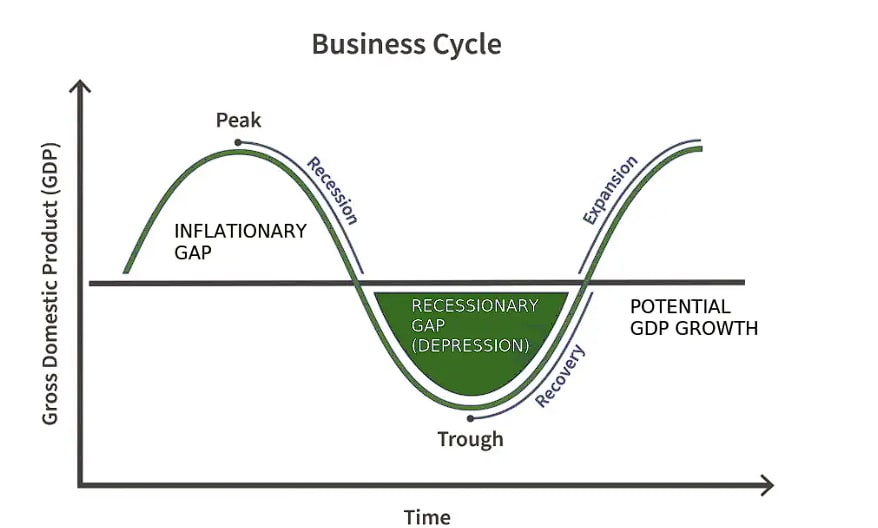Business Cycle
The business cycle refers to the fluctuations in business activities caused by changes in economic conditions over a period of time. It is also known as the trade cycle or economic cycle. Understanding the business cycle can help individuals and organizations make better financial and strategic decisions.
The business cycle represents the rise and fall of gross domestic product (GDP) around its long-term growth trend. These cyclical fluctuations encompass periods of economic expansion and contraction.
Types of Business Cycles
The business cycle can be classified into the following types:
- Short Kitchin Cycle
- Longer Juglar Cycle
- Very Long Kondratieff Wave
Short Kitchin Cycle
This is a minor cycle with a duration of approximately 40 months. It is characterized by short-term fluctuations in economic activity.
Longer Juglar Cycle
A major cycle composed of three minor cycles, typically lasting around 10 years. It reflects significant changes in economic trends.
Very Long Kondratieff Wave
These are extended cycles that encompass six major cycles and span over 60 years. They represent profound and long-term shifts in economic growth.
Phases of the Business Cycle
The business cycle has four distinct phases that describe the changes in economic activity within a country or region:
- Expansion
- Peak
- Contraction
- Trough

Expansion
The expansion phase is the initial stage of the business cycle, often referred to as the growth phase. It is characterized by an increase in various economic factors, such as production, employment, wages, profits, demand, and supply. Organizations focus on boosting the demand for their products or services during this period.
Key features of the expansion phase include:
- Increased demand
- Growth in income and profits
- Rising competition
- Increased advertising
- Implementation of new policies
- Development of brand loyalty
During this phase, creditors are more willing to lend money at higher interest rates due to borrowers' improved financial conditions. Investments flourish as organizations and individuals utilize idle funds for various purposes. The expansion phase continues as long as economic conditions remain favorable.
Peak
The peak phase follows expansion, marking the highest point of economic activity. At this stage, businesses achieve stable profits and begin planning for further growth.
Features of the peak phase include:
- High demand and supply levels
- Maximum revenue and market share
- Reduced advertising efforts
- Strong brand image
In this phase, economic factors such as production, sales, and employment reach their highest levels but no longer grow.
Contraction
After reaching the peak, an organization or economy enters the contraction phase, also known as a recession. This phase is marked by a decline in economic activity due to reasons such as policy changes, increased competition, unfavorable economic conditions, or labor issues.
Key characteristics of the contraction phase:
- Decreased demand
- Loss of sales and revenue
- Decline in market share
- Increased competition
Trough
The trough phase represents the lowest point of the business cycle. During this stage, organizations face significant losses, reduced demand, and declining profits. Recovery measures are often initiated to stabilize the economy.
Features of the trough phase:
- Lowest income levels
- Loss of customers
- Cost-cutting measures
- Sharp decline in market share
In this phase, the economy may experience negative growth, with rapid declines in national income and expenditure.